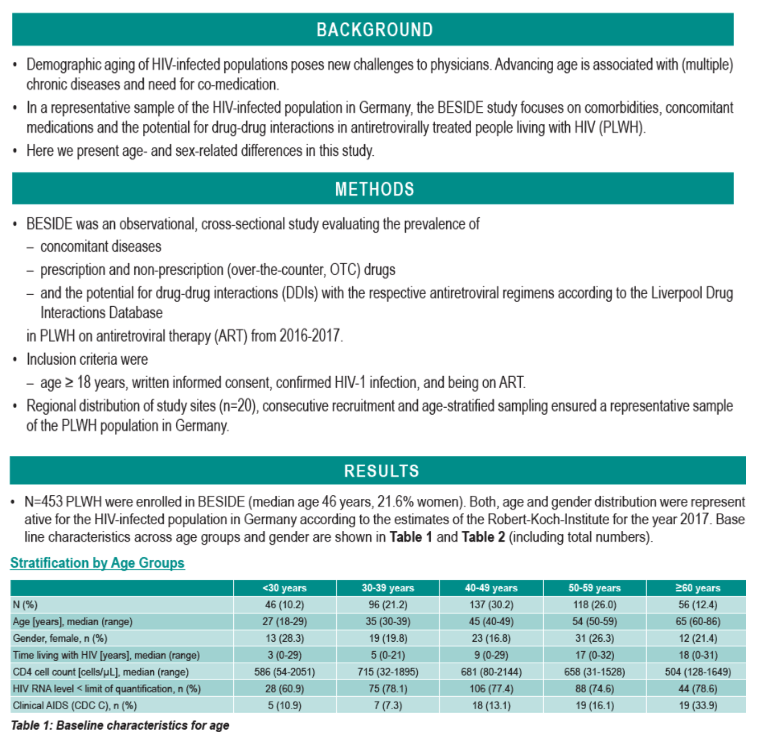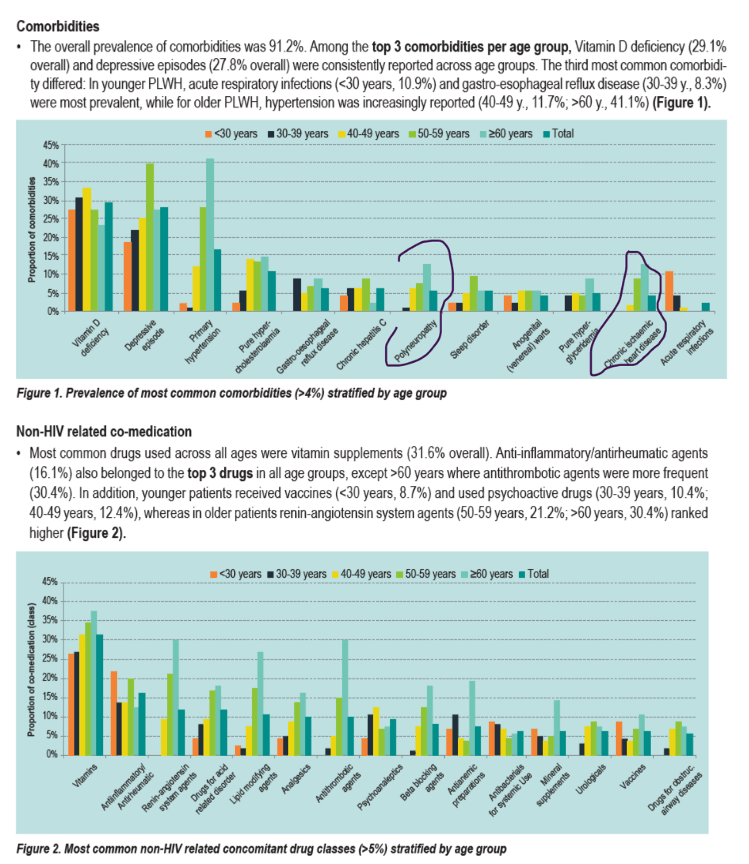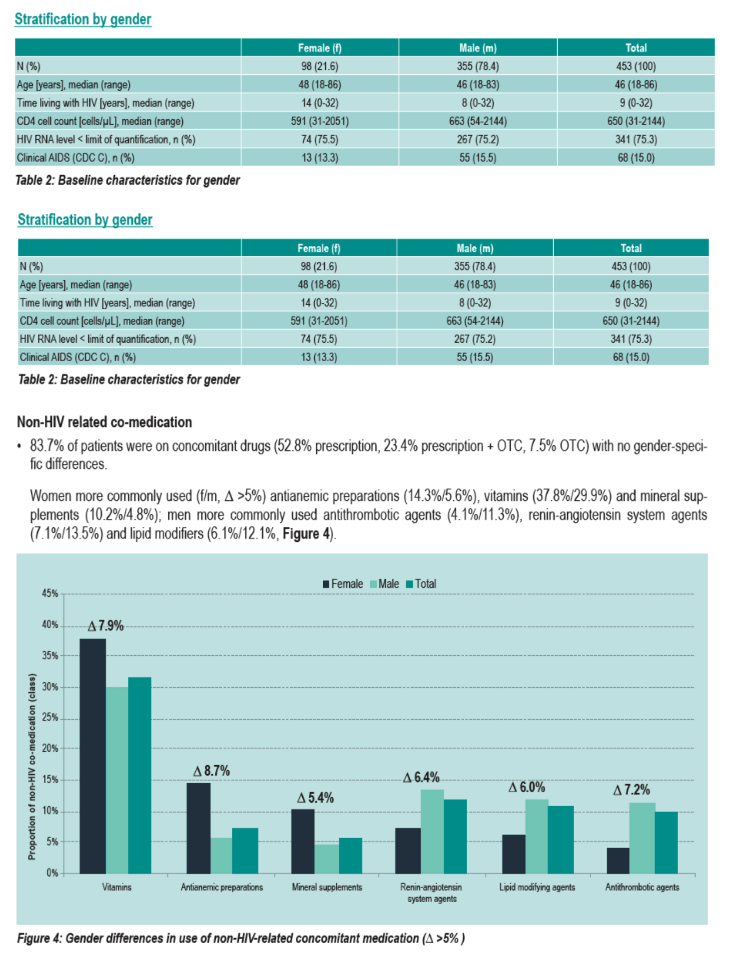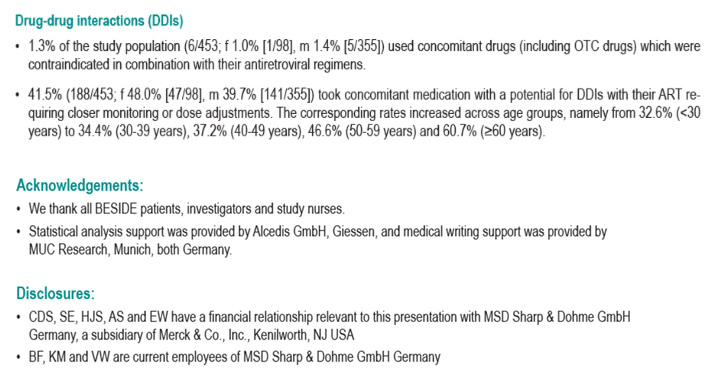 |
 |
 |
| |
BESIDE - Age- and sex-related differences in concomitant diseases
and use of co-medication in patients with treated HIV-infection in Germany
|
| |
| |
....'even at young ages comorbidity prevalence is high for certain comorbidities, polypharmacy too across age groups'..... ...hypertension, vit D, depression, neuropathy, heart disease most common', Jules
N=453 PLWH were enrolled in BESIDE (median age 46 years, 21.6% women).
The overall prevalence of comorbidities was 91.2%. . see figure 1, most common comorbidities in HIV+: vit D deficiency, depression, neuropathy, heart disease.
Women more often (f/m, difference (Δ) >5%) suffered from nutritional anemias (11.2%/3.9%), other nutritional deficiencies (38.8%/27.9%), bone density/structure disorders (9.2%/1.4%) and thyroid gland disorders (10.2%/3.9%). Conversely, metabolic disorders (10.2%/20.6%), sexually transmissible infections (2.0%/8.7%), polyneuropathies/peripheral nervous system disorders (1.0%/6.8%) and dorsopathies (2.0%/7.8%) were more common in men (Figure 3).
Deforming dorsopathy is a state with vertebrae displacement and changes of intervertebral disks. Osteochondrosis, spondylolisthesis (vertebrae displacement), lateral and front - back deformations of backbone (scoliosis, kyphosis, lordosis) refer to such dorsopathy.
21st International Workshop n Co-morbidities and Adverse Drug Reactions in HIV
Nov 5-6 2019 Basel
B. Funke1, C. D. Spinner2, S. Esser3, H.-J. Stellbrink4, A. Stoehr5, E. Wolf6, K. Martin1, V. Witte1
1MSD Sharp & Dohme GmbH, Medical Affairs, Haar; 2University Hospital rechts der Isar, Department of Medicine II, Munich; 3University Hospital Essen, University of Duisburg-Essen, Clinic for Dermatology, Essen; 4Infectiology Center Hamburg (ICH), Hamburg; 5ifi Institute for Interdisciplinary Medicine, Hamburg; 6MVZ Karlsplatz, Munich, all Germany.

program abstract
Age- and sex-related differences in concomitant diseases and use of co-medication in patients with
treated HIV infection in Germany
B Funke1, CD Spinner2, S Esser3, H-J Stellbrink4, A Stoehr5, E Wolf6, K Martin1, V Witte1
Background: Demographic ageing of HIV-infected populations poses new challenges to physicians. Advancing age is associated with (multiple) chronic diseases and need for co-medication.
Methods: BESIDE was a cross-sectional study evaluating the prevalence of concomitant diseases and prescription and over the counter co-medication in people
living with HIV (PLWH) on antiretroviral therapy from 2016-2017. Regional distribution of study sites (n=20), consecutive recruitment and age-stratified sampling
ensured a representative sample of the PLWH population in Germany.
Results: n=453 PLWH were enrolled: female 22%, median age 46 years (y), median time living with HIV 9 y, CDC C 15%, median CD4 count 650 cells/μl.
Among the top three comorbidities per age group, vitamin D deficiency (29% overall) and depressive episodes (28% overall) were consistently reported across age groups. The third most common comorbidity differed: in younger PLWH, acute respiratory infections (<30 y, 11%) and gastro-oesophageal reflux disease (30-39 y,
8%) were most prevalent, while for older PLWH, hypertension was increasingly reported (40-49 y, 12%;
>60 y, 41%).
Women more often (f/m, difference Δ>5%) suffered from nutritional anaemias (11%/4%), other nutritional deficiencies (39%/28%), bone density/structure disorders
(9%/1%) and thyroid gland disorders (10%/4%).
Conversely, metabolic disorders (10%/21%), sexually transmissible infections (2%/9%), polyneuropathies/peripheral nervous system disorders (1%/7%) and dorsopathies (2%/8%) were more common in men.
Most common drugs used across all ages were vitamin supplements (32% overall). Anti-inflammatory/antirheumatic agents (16%) also belonged to the top three
drugs in all age groups, except >60 y where antithrombotic agents were more frequent (30%). In addition, younger patients received vaccines (<30 y, 9%) and
used psychoactive drugs (30-39 y, 10%; 40-49 y, 12%), whereas in older patients renin-angiotensin system agents (50-59 y, 21%; >60 y, 30%) ranked higher.
Women more commonly used (f/m, Δ >5%) antianaemia preparations (14%/6%), vitamins (38%/30%) and mineral supplements (10%/5%); men more commonly used antithrombotic agents (4%/11%), renin-angiotensin system agents (7%/14%) and lipid modifiers (6%/12%).
Conclusions: Although prevalence of concomitant diseases and use of co-medication among PLWH in Germany are high across gender and all ages, the
disease and drug patterns change in an age- and sex related manner.




|
| |
|
 |
 |
|
|